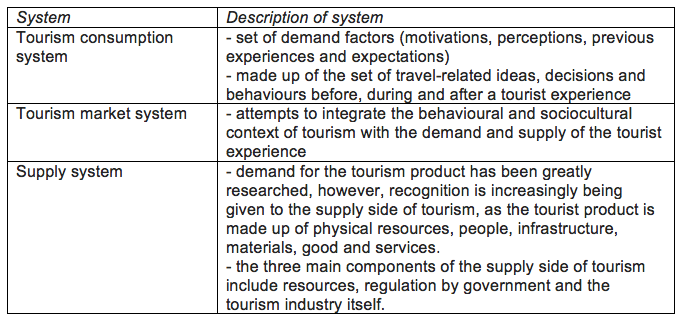| An Introduction To Tourism |
|
TOURISM INDUSTRY DEPTH
Issues for managing tourism through a systems approach
The tourist goes through several destinations during a tourist experience; the generating region, the transit region and the actual destination (Leiper, 1979). At each of these stages, the tourist may be in a different psychological state, thus their motivations for travel may evolve as they gather new experiences and memories (Hall, 2005a). Thus, these psychological and geographical shifts significantly impact tourism marketing and promotion.
An individual who has a tourist experience will be limited by the values and ideals of their culture. Thus the tourist experience is culturally bound by the society from which the tourist comes.
A tourist's demand is greatly influenced by their motivations, perceptions, previous experiences and expectations. These are different for all tourists, depending on their sociocultural context, thus they must first be understand by the tourism industry so a memorable and satisfactory tourist experience can be ensured.
An individual who has a tourist experience will be limited by the values and ideals of their culture. Thus the tourist experience is culturally bound by the society from which the tourist comes.
A tourist's demand is greatly influenced by their motivations, perceptions, previous experiences and expectations. These are different for all tourists, depending on their sociocultural context, thus they must first be understand by the tourism industry so a memorable and satisfactory tourist experience can be ensured.
Link between the tourist and the tourism industry
The tourist and the tourism share a two-way relationship. The tourist affects the make up of resources and products on which the tourism industry is built and the tourism industry affects the tourists motivations and ideals.
The tourist experience itself is co-created by both the producer (tourism industry) and consumer (tourist) (Smith, 2004). The tourism industry is thus defined by the tourist. According to the demand approach to defining the tourism industry, anything that is purchased or consumed by a tourist is part of the tourism industry, thus they are dependent upon each other.
The tourist experience itself is co-created by both the producer (tourism industry) and consumer (tourist) (Smith, 2004). The tourism industry is thus defined by the tourist. According to the demand approach to defining the tourism industry, anything that is purchased or consumed by a tourist is part of the tourism industry, thus they are dependent upon each other.
Complex interconnections and systems that are tourism
Tourism can be seen as an interrelated system, an assemblage of elements forming a unitary whole (Hall, 2007).
At a geographic level, three elements can be identified:
- generating region
- transit region
- destination region
This system is useful for identifying the flow of tourists from one region to another
Table 1 shows the different systems that are tourism. These will be displayed by each system and a subsequent description. This was derived from reviewing credible literature.
Table 1: Systems that are tourism
At a geographic level, three elements can be identified:
- generating region
- transit region
- destination region
This system is useful for identifying the flow of tourists from one region to another
Table 1 shows the different systems that are tourism. These will be displayed by each system and a subsequent description. This was derived from reviewing credible literature.
Table 1: Systems that are tourism
Source: Hall (2007).
Key points:
- there are three main systems involved in tourism
- there is a system based on the demand side of the market
- there is a system based on the supply side of the market
- there is a system which attempts to integrate the demand and supply sides of the market
Key points:
- there are three main systems involved in tourism
- there is a system based on the demand side of the market
- there is a system based on the supply side of the market
- there is a system which attempts to integrate the demand and supply sides of the market

